Gender bias generally encompasses prejudiced treatment and preconceptions about a person’s abilities, duties or conducts based on his/her sex or gender. Much like racial discrimination, prolonged exposure to gender bias (coupled with gender stereotypes, cultural pressures, and societal expectations) has long-term mental health implications 1 Hennein, R., Poulin, R., Gorman, H., & Lowe, S. R. (2023). Gender Discrimination and Mental Health Among Health Care Workers: Findings from a Mixed Methods Study. Journal of women’s health (2002), 32(7), 823–835. https://doi.org/10.1089/jwh.2022.0485 .
This necessitates the need to understand and acknowledge the gender bias meaning, as well as address gender bias in the workplace, education, or daily interactions.
Signs Of Gender Bias
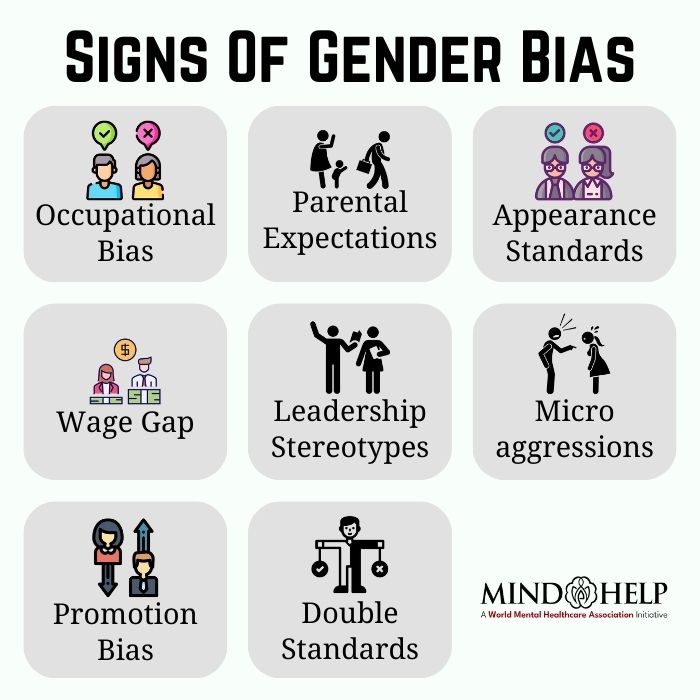
The common signs 2 Mizock, L., & Brubaker, M. (2021). Treatment experiences with gender and discrimination among women with serious mental illness. Psychological services, 18(1), 64–72. https://doi.org/10.1037/ser0000346 of gender bias include:
- Discrimination based on sex preference.
- Building gender stereotypes by ascribing a specific sex certain traits or roles.
- Inadequate opportunities and discrimination in education, job promotion, and career growth.
- Microaggressions, like prejudiced words or actions—intentional or unintentional.
- Pay disparity between sexes in similar positions.
- Non-inclusion of certain genders (like women or members of the LGBTQIA+ community) in certain professions and top positions.
- Differences and discrimination in cultural and societal gender expectations 3 Vlassoff C. (2007). Gender differences in determinants and consequences of health and illness. Journal of health, population, and nutrition, 25(1), 47–61. .
- Sexual objectification, bullying, and harassment.
- Subconscious attitudes and beliefs that influence gender bias and differential treatment.
Read More About Bullying Here
Gender Bias In Films
Gender bias examples are heavily explored in films 4 Matud, M. P., López-Curbelo, M., & Fortes, D. (2019). Gender and Psychological Well-Being. International journal of environmental research and public health, 16(19), 3531. https://doi.org/10.3390/ijerph16193531 . The 1998 Disney film “Mulan” explores gender bias and societal expectations in Mulan, a female protagonist with warrior qualities. “Legally Blonde” (2001) uses Reese Witherspoon’s Elle Woods to shred apart the gender bias that plague blonde women. The 2003 comedy “Down With Love” examines gender bias prevalent in romantic relationships. The contemporary “Mona Lisa Smile” advocates the role of education and gender equality in doing away with gender prejudice.
Similarly, the 1989 cult classic “Dead Poets Society” deconstructs gender bias and stereotypes in the male sex. “The Danish Girl” and “Tangerine,” both released in 2015, are lauded for the portrayal of gender bias in the LGBTQIA+ community. TV-series like “Sex Education” (2019-23) and “2 Broke Girls” (2011-17) have also shattered gender stereotypes and bias in recent years.
Read More About Stereotypes Here
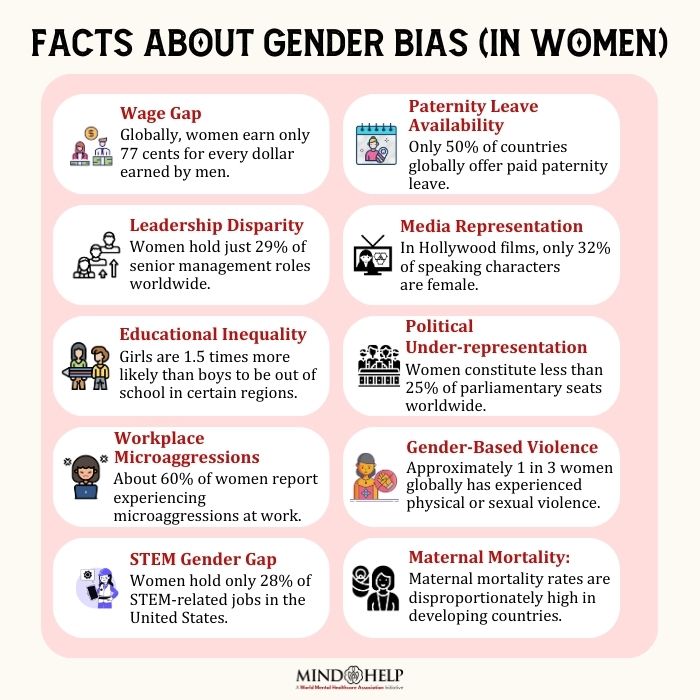
Gender Bias Examples In Different Domains Of Life
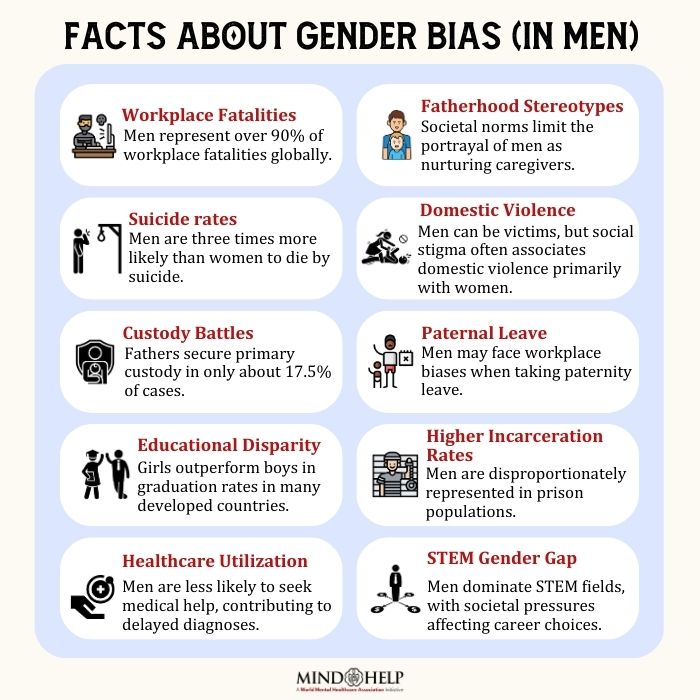
Gender bias is prevalent in different domains of life 5 Tedstone Doherty, D., & Kartalova-O’Doherty, Y. (2010). Gender and self-reported mental health problems: predictors of help seeking from a general practitioner. British journal of health psychology, 15(Pt 1), 213–228. https://doi.org/10.1348/135910709X457423 . Gender bias in the workplace, for instance, often manifest as unequal pay and access to unequal opportunities. Women have few chances of promotion compared to men, and stereotypes dictate that certain job positions are assigned according to one’s gender, thereby reinforcing the system inequalities. The unequal work environments at times are linked to microaggressions, such as subtle discriminatory comments and increased vulnerability to sexual predatory behavior.
Power imbalances among genders in the context of relationships are displayed in unequal decision-making opportunities and partner submission. In most cases, the male partners are expected to shoulder the economic burden. The nurturing and emotional roles are almost always shifted to the female partners. If the female partners have sound careers, they are often vilified for their career/professional choices and are accused of inadequate involvement in the respective intimate relationship.
Read More About Decision-Making Here
Gender bias present within families can be seen in the division of household chores because traditional gender roles often influence these expectations. Educational opportunities and the right to work may be unequally encouraged based on traditional gender norms. Moreover, partiality on inheritance may lead to unfair distribution of family wealth.
People can also harbor gender bias independent of contexts 6 Amering M. (2021). Mental health and human rights of women. European Psychiatry, 64(Suppl 1), S45–S46. https://doi.org/10.1192/j.eurpsy.2021.150 . An individual’s social and personal life can influence his/her gender notions. For example, several factors (like self-inflicted homophobia or stigmatizing of fluid gender identities) can curtail personal choices, expressions and reinforce conventional gender identities.
Read More About Homophobia Here
Gender Bias And Mental Health
Gender bias and mental health are inversely related 7 Yu S. (2018). Uncovering the hidden impacts of inequality on mental health: a global study. Translational psychiatry, 8(1), 98. https://doi.org/10.1038/s41398-018-0148-0 . Prolonged exposure to gender discrimination can leave people with low self-esteem and self-worth, as well as internalized guilt and shame. Limited opportunities and curbed agency and self-expression may lead to increased levels of stress, anxiety, self-loathing, and depression. These, in turn, can exacerbate mental health conditions like self-harm, substance addiction, personality disorders 8 Jane, J. S., Oltmanns, T. F., South, S. C., & Turkheimer, E. (2007). Gender bias in diagnostic criteria for personality disorders: an item response theory analysis. Journal of abnormal psychology, 116(1), 166–175. https://doi.org/10.1037/0021-843X.116.1.166 , behavioral issues, etc.
Read More About Stress Here
How To Overcome Gender Bias
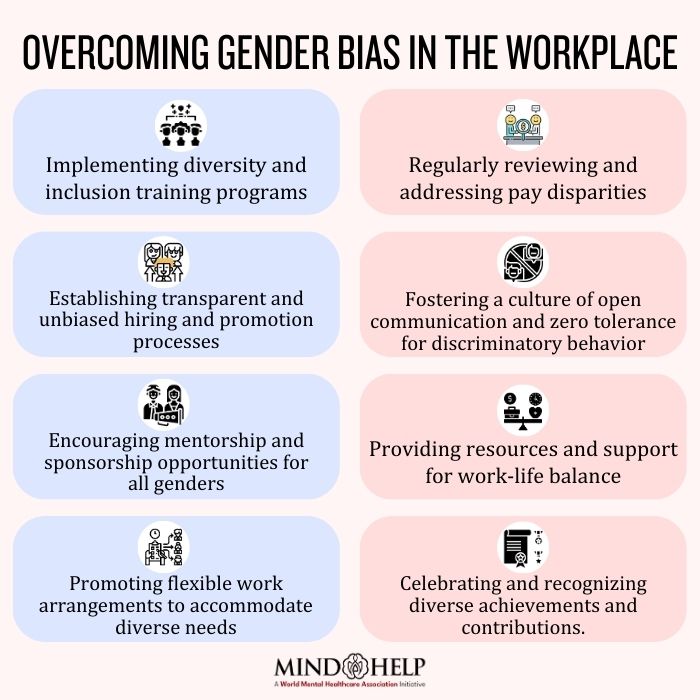
Consider the following tips 9 Comacchio, C., Antolini, G., Ruggeri, M., & Colizzi, M. (2022). Gender-Oriented Mental Health Prevention: A Reappraisal. International journal of environmental research and public health, 19(3), 1493. https://doi.org/10.3390/ijerph19031493 to overcome gender bias in the workplace, academic life, or daily interactions:
- Educate yourself about gender bias. Be aware of your own prejudices.
- Take part in various workshops and training to sensitize yourself about the issues of gender bias.
- Nurture a culture, at work and at home, that is gender inclusive and has a wide range of leadership representation.
- Implement and follow open policies and guidance programs at work aimed at addressing sex discrimination.
- Advocate for salary disclosure and rules guaranteeing equal remunerations for equal work by both genders.
- Actively interrogate, criticize or oppose gender bias in media, as well as everyday conversations and interactions.
- Encourage individuals to speak out against gender biased behaviors assertively.
- Promote equivalent opportunities for all genders, personally and professionally.
- Support legal reforms addressing sex-based discrimination.
- Establish platforms for experience sharing and strategies on how to overcome gender prejudice.
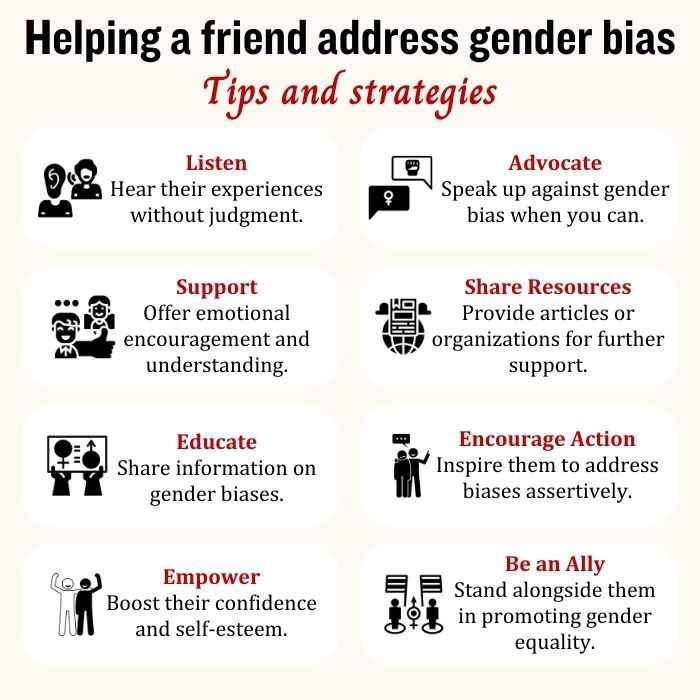
Takeaway
Gender bias meaning deeply ingrained societal norms and stereotypes persists unchecked across the globe. Addressing these bias requires a collective effort to challenge preconceived notions, promote gender equality, and foster inclusive environments that recognize and celebrate the diverse contributions of all genders. By fostering awareness, education, and systemic change, societies can work towards dismantling gender bias and mental health issues that accompany these prejudices.
At A Glance
- Gender bias, meaning deeply ingrained societal norms and stereotypes, results in unfair differences in the way sexes or genders are treated.
- Gender bias and mental health are inversely related.
- Gender bias examples are prevalent in different domains of life, be it the workplace, academia, or daily life.
- Exposure to gender bias in the workplace or at home can trigger depression, anxiety, low self-esteem, addiction, or self-harm.
- Gender bias can be addressed through self-awareness and education.
Frequently Asked Questions (FAQs)
1. What Is The Best Practice For Challenging Gender Bias?
The best practice in challenging and eliminating gender bias involves education and awareness in fostering an inclusive environment.
2. What Is The Role Of Gender Bias?
The role of gender bias is to perpetuate stereotypes, limit opportunities, and undermine equality based on gender.
3. What Is The Most Common Example Of Gender Bias?
One of the common gender bias examples is the assumption that certain professions or roles are more suitable for one gender over the other.
4. How Do You Identify Gender Bias?
Gender bias is identified by examining unequal treatment, stereotypes, or prejudices based on gender in the workplace, education, or daily interactions.















